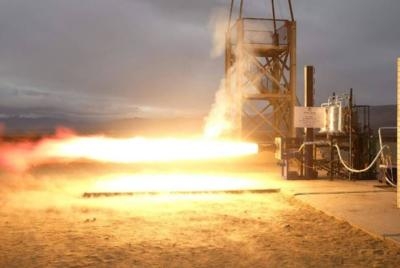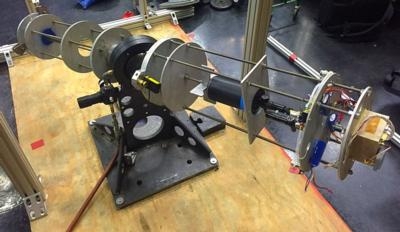Selected U.S. Companies Will Provide Technical Expertise And Test Facilities, Hardware And Software
NASA is seeking partnerships with U.S. companies focused on industry-developed space technologies that can advance the commercial space sector and benefit future NASA missions through the “Announcement of Collaborative Opportunity (ACO)” solicitation released by NASA’s Space Technology Mission Directorate (STMD).

NASA centers will partner with the companies that are awarded projects under the ACO to provide technical expertise and test facilities as well as hardware and software to aid in maturing technologies that can enable or enhance space systems and closely related subsystems. NASA's investments in industry partnerships can reduce the cost of the development of technologies and accelerate the infusion of emerging commercial space system capabilities into space missions.
“This ACO continues to build on STMD’s strategy to advance commercial space capabilities aligned with NASA’s long-term strategic goals,” said Steve Jurczyk, associate administrator for STMD at NASA Headquarters in Washington. “These partnerships will leverage NASA’s unique engineering expertise and test facilities to increase U.S. industry competitiveness in the space sector.”
For this opportunity, NASA is seeking partnerships in the following technology areas:
Topic 1: Small Launch Vehicle Technology Development:
Commercial demand for dedicated launch of small spacecraft is growing. As NASA considers utilizing small spacecraft to augment primary mission objectives, the agency is interested in accelerating the development of promising technologies for small spacecraft launch systems with the goal of enabling commercial services that have potential for infusion into future NASA missions or infrastructure.
Topic 2: Reliable Electronics Technology Development:
Commercial off-the-shelf electronics are often unreliable when exposed to the full range of space conditions. NASA is interested in partnering with industry to support the emergence of new commercial capabilities to produce low-cost yet reliable electronics for space that are of interest to the commercial space sector and have potential for infusion into future NASA missions or infrastructure.
Topic 3: Advanced Communications Technology Development:
Communications for command, control, and data downlink are a critical element of every space mission. Emerging business and technology trends could provide opportunities to solve NASA’s long-term communications infrastructure challenges to enable the agency to continue to deliver end-to-end command, telemetry, and data transmission services for the next generation of science and human explorations missions. NASA is interested in partnering with industry to support the emergence of advanced commercial space telecommunications capabilities that have potential for infusion into future NASA missions or infrastructure.
Topic 4: In-space Propulsion Technology Development:
NASA is interested in partnerships focused on two significant classes of in-space propulsion systems. First, the range of applications that can take advantage of small spacecraft platforms and low-cost space access is limited without adequate propulsion. Advancing small spacecraft chemical propulsion systems and sub-kW power level electric propulsion systems is a pathway to increasing the utilization and effectiveness of small spacecraft launched either as a secondary payload or as a dedicated payload for both the government and private sector. Second, larger-scale chemical cryogenic propulsion systems also are needed to support the expansion of commercial capabilities and for infusion into future NASA transportation architectures. Focused technology development partnerships can help bring both classes of in-space propulsion capabilities closer to market.

Partnerships must focus on advancing commercially-developed technologies that can benefit both the commercial and government use of space. Mandatory preliminary proposals for this opportunity are due by March 15. Feedback will be provided on preliminary proposals. Final proposals are due May 31. Awards will be made in the form of non-reimbursable Space Act Agreements (no funds exchanged). Proposals must be led by a U.S. for-profit entity. NASA expects to select projects worth a combined total of approximately $10 million to U.S. industry.
STMD is responsible for developing the crosscutting, pioneering, new technologies and capabilities needed to achieve NASA missions. STMD rapidly innovates, develops, demonstrates, and infuses revolutionary, high-payoff technologies through transparent, collaborative partnerships, expanding the boundaries of the aerospace enterprise. Projects resulting from the Tipping Point solicitation will enable public-private partnerships managed by programs within STMD.
(Images provided with NASA news release)
 Airbus Racer Helicopter Demonstrator First Flight Part of Clean Sky 2 Initiative
Airbus Racer Helicopter Demonstrator First Flight Part of Clean Sky 2 Initiative Diamond's Electric DA40 Finds Fans at Dübendorf
Diamond's Electric DA40 Finds Fans at Dübendorf ANN's Daily Aero-Term (04.23.24): Line Up And Wait (LUAW)
ANN's Daily Aero-Term (04.23.24): Line Up And Wait (LUAW) NTSB Final Report: Extra Flugzeugbau GMBH EA300/L
NTSB Final Report: Extra Flugzeugbau GMBH EA300/L Classic Aero-TV: 'Never Give Up' - Advice From Two of FedEx's Female Captains
Classic Aero-TV: 'Never Give Up' - Advice From Two of FedEx's Female Captains




